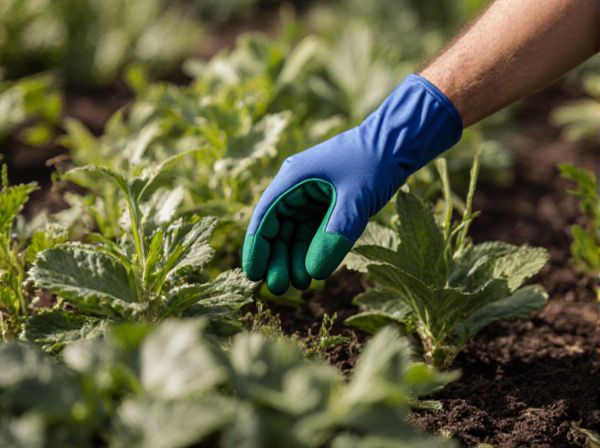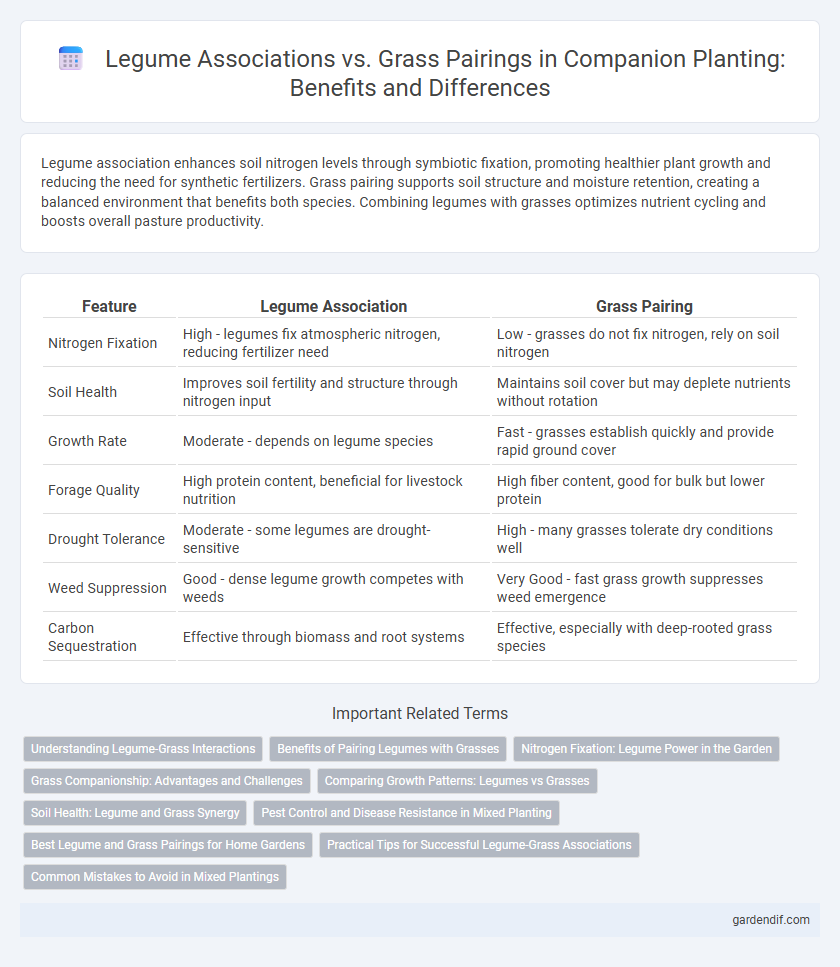
Legume association vs grass pairing Illustration
Legume association enhances soil nitrogen levels through symbiotic fixation, promoting healthier plant growth and reducing the need for synthetic fertilizers. Grass pairing supports soil structure and moisture retention, creating a balanced environment that benefits both species. Combining legumes with grasses optimizes nutrient cycling and boosts overall pasture productivity.
Table of Comparison
| Feature | Legume Association | Grass Pairing |
|---|---|---|
| Nitrogen Fixation | High - legumes fix atmospheric nitrogen, reducing fertilizer need | Low - grasses do not fix nitrogen, rely on soil nitrogen |
| Soil Health | Improves soil fertility and structure through nitrogen input | Maintains soil cover but may deplete nutrients without rotation |
| Growth Rate | Moderate - depends on legume species | Fast - grasses establish quickly and provide rapid ground cover |
| Forage Quality | High protein content, beneficial for livestock nutrition | High fiber content, good for bulk but lower protein |
| Drought Tolerance | Moderate - some legumes are drought-sensitive | High - many grasses tolerate dry conditions well |
| Weed Suppression | Good - dense legume growth competes with weeds | Very Good - fast grass growth suppresses weed emergence |
| Carbon Sequestration | Effective through biomass and root systems | Effective, especially with deep-rooted grass species |
Understanding Legume-Grass Interactions
Legume association enhances nitrogen fixation, improving soil fertility and supporting grass growth through symbiotic Rhizobium bacteria. Grass pairing benefits from this nutrient enrichment, promoting robust biomass production and increased forage quality in mixed swards. Understanding legume-grass interactions is essential for sustainable pasture management and optimizing ecosystem productivity.
Benefits of Pairing Legumes with Grasses
Pairing legumes with grasses enhances soil fertility by increasing nitrogen fixation, which reduces the need for synthetic fertilizers and promotes sustainable agriculture. This association improves forage quality and yield, benefiting livestock nutrition and farm productivity. Moreover, the diverse root systems of legumes and grasses contribute to better soil structure and erosion control, supporting long-term land health.
Nitrogen Fixation: Legume Power in the Garden
Legume association enhances nitrogen fixation by forming symbiotic relationships with Rhizobium bacteria, converting atmospheric nitrogen into plant-usable forms, which significantly boosts soil fertility. Grass pairing alone offers limited nitrogen fixation since grasses lack this symbiosis, often requiring external nitrogen inputs for optimal growth. Integrating legumes in garden companion planting maximizes natural nitrogen enrichment, reducing fertilizer dependence and promoting sustainable soil health.
Grass Companionship: Advantages and Challenges
Grass companionship enhances soil structure and moisture retention, promoting healthier root systems and increased biomass production. This association improves nutrient cycling, particularly nitrogen availability, benefiting companion legume growth and overall pasture productivity. However, challenges include competition for light and water, requiring careful management of species selection and planting density to optimize mutual benefits.
Comparing Growth Patterns: Legumes vs Grasses
Legumes exhibit nitrogen-fixing capabilities that enhance soil fertility, promoting steady growth even in nutrient-poor conditions, while grasses rely on soil nitrogen availability and tend to grow rapidly with a fibrous root system that stabilizes soil. Legume growth patterns often involve slower initial development but sustained biomass accumulation, contrasted with grasses that display faster, early-stage shoot growth but may require more frequent nutrient inputs. This complementary dynamic in legume and grass pairing optimizes resource use, improving ecosystem productivity and resilience.
Soil Health: Legume and Grass Synergy
Legume association enhances soil health by fixing atmospheric nitrogen through symbiotic bacteria, enriching soil fertility and reducing the need for synthetic fertilizers. Grass pairing complements this process by improving soil structure and increasing organic matter through extensive root systems and biomass production. Together, legume and grass synergy promotes nutrient cycling, moisture retention, and microbial diversity, leading to sustainable and resilient soil ecosystems.
Pest Control and Disease Resistance in Mixed Planting
Legume association with grasses enhances pest control by attracting beneficial insects that prey on common grass pests, reducing the need for chemical pesticides. This mixed planting improves disease resistance through nitrogen fixation by legumes, which boosts grass vigor and immunity against fungal pathogens. Diverse root structures in legume-grass pairings also disrupt pest life cycles and enhance soil microbial communities, further protecting plants from infestations and diseases.
Best Legume and Grass Pairings for Home Gardens
Pea and oat form one of the best legume and grass pairings for home gardens, benefiting soil nitrogen levels and improving overall plant health. Clover combined with ryegrass provides excellent ground cover and enhances soil fertility through nitrogen fixation. Vetch and fescue also create a synergistic association, promoting robust growth and minimizing weed competition.
Practical Tips for Successful Legume-Grass Associations
Successful legume-grass associations enhance soil nitrogen fixation and improve forage quality, requiring careful species selection such as alfalfa with orchardgrass or red clover with timothy. Optimal seeding rates balance legume and grass proportions, typically 20-30% legumes and 70-80% grasses by seed weight, ensuring healthy competition and growth. Maintaining appropriate soil pH between 6.0 and 7.0 and regular monitoring for pest management improves establishment and long-term productivity of mixed stands.
Common Mistakes to Avoid in Mixed Plantings
In mixed plantings, a common mistake is overlooking the specific nutrient requirements and root structures of legumes versus grasses, which can lead to competition rather than mutual benefit. Farmers often fail to account for the differing growth rates, causing dominant grasses to overshadow slower-growing legumes, reducing nitrogen fixation efficiency. Proper spacing, timed planting, and species selection are critical to optimize the symbiotic relationship and maximize yield in legume-grass associations.
Legume association vs grass pairing Infographic

 gardendif.com
gardendif.com